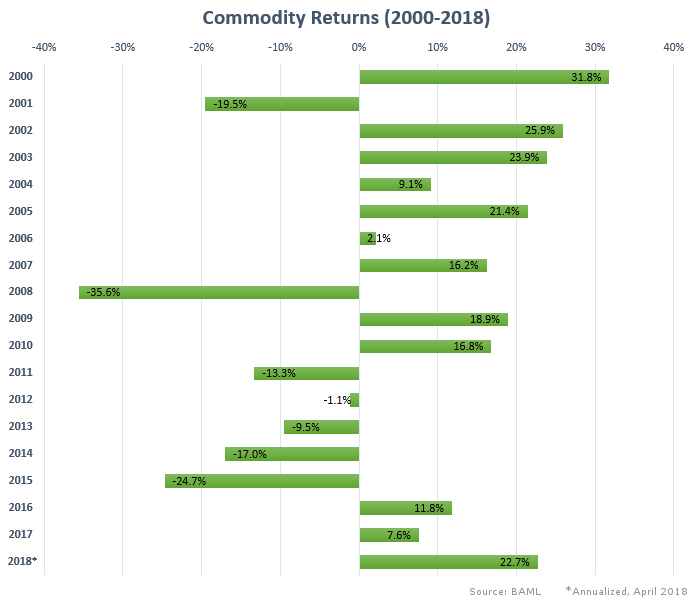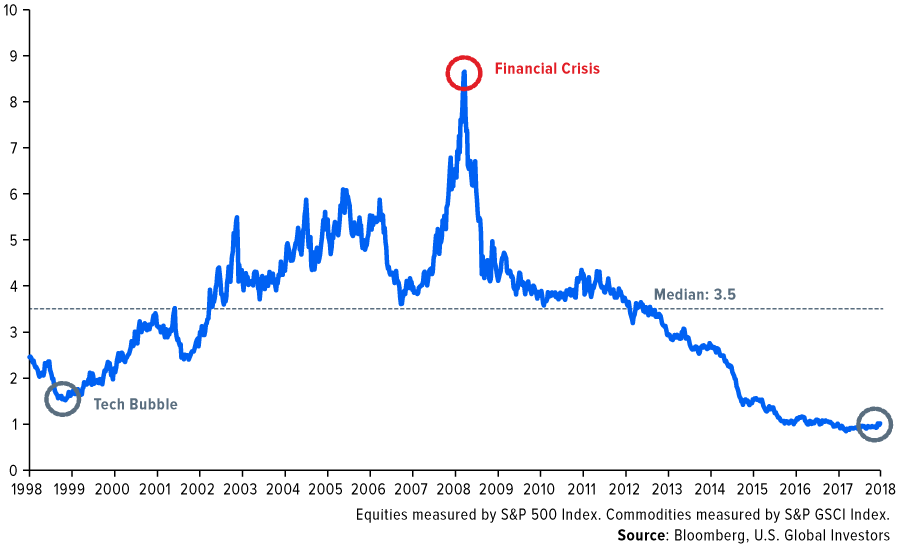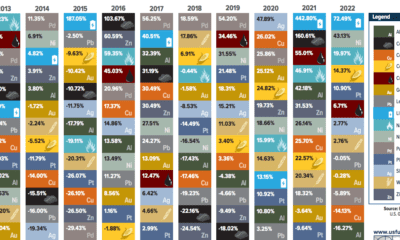For now, such a claim could perhaps be considered both bold and premature – but there does seem to be some compelling evidence that is mounting to back it up.
The Asset Quilt
According to the most recent “Asset Quilt of Total Returns” put together by Bank of America Merrill Lynch, commodities are the top returning asset class of 2018 so far. The chart, which shows the total returns of asset classes over the years, has commodities at an annualized return of 22.7% year-to-date. Right behind it is gold, which sits at 11.6% on an annualized basis:
Interestingly, commodities haven’t been on top of BAML’s chart since the years 2000 and 2002, which were at the beginning of the last commodity supercycle.
A Deeper Dive
Here is how commodities have fared from 2000 to 2018, based on annual returns. If the commodity sector keeps the pace for the rest of 2018, this will be the best year for the asset class since 2003.
For various reasons, commodities have bounced back in the last three years. The return of oil prices have helped to resurrect the sector. Ironically, the anticipated metal demand from renewable energy – which will be used to wean society off of fossil fuel consumption – is also a massive driver behind commodities right now. Not only are base metals like copper, aluminum, and nickel essential for the “electrification of everything”, but lesser-known materials like lithium, cobalt, rare earths, vanadium, uranium, and graphite all play essential roles as well. They do everything from enabling lithium-ion batteries and vanadium flow batteries, to making possible the permanent magnets that generate electricity from wind turbines. – Goldman Sachs, February 2018 Not surprisingly, here are how metal and energy commodities have performed since January 1, 2016: Some minor metals, like vanadium, have increased by over 400% in price in the last two years. That begs the question: how much room could there possibly be for price appreciation left?
Supercycle Potential
As Frank Holmes of U.S. Global Investors described in a recent post, the last boom was so prolific that investing in an index tracking commodities (such as the S&P GSCI) in 2000 would have resulted in the equivalent of 10% annual returns for ten years. He also shared this chart, which shows the ratio in value between commodities and the S&P 500:
In other words, commodities seem to be more undervalued than any time in the past 20 years, at least relative to equity indices such as the S&P 500. Even if the above ratio comes back up to the median of 3.5, it’s clear that there could still be vast amounts of opportunity available in the sector for investors. on
#1: High Reliability
Nuclear power plants run 24/7 and are the most reliable source of sustainable energy. Nuclear electricity generation remains steady around the clock throughout the day, week, and year. Meanwhile, daily solar generation peaks in the afternoon when electricity demand is usually lower, and wind generation depends on wind speeds.As the use of variable solar and wind power increases globally, nuclear offers a stable and reliable backbone for a clean electricity grid.
#2: Clean Electricity
Nuclear reactors use fission to generate electricity without any greenhouse gas (GHG) emissions.Consequently, nuclear power is the cleanest energy source on a lifecycle basis, measured in CO2-equivalent emissions per gigawatt-hour (GWh) of electricity produced by a power plant over its lifetime. The lifecycle emissions from a typical nuclear power plant are 273 times lower than coal and 163 times lower than natural gas. Furthermore, nuclear is relatively less resource-intensive, allowing for lower supply chain emissions than wind and solar plants.
#3: Stable Affordability
Although nuclear plants can be expensive to build, they are cost-competitive in the long run. Most nuclear plants have an initial lifetime of around 40 years, after which they can continue operating with approved lifetime extensions. Nuclear plants with lifetime extensions are the cheapest sources of electricity in the United States, and 88 of the country’s 92 reactors have received approvals for 20-year extensions. Additionally, according to the World Nuclear Association, nuclear plants are relatively less susceptible to fuel price volatility than natural gas plants, allowing for stable costs of electricity generation.
#4: Energy Efficiency
Nuclear’s high energy return on investment (EROI) exemplifies its exceptional efficiency. EROI measures how many units of energy are returned for every unit invested in building and running a power plant, over its lifetime. According to a 2018 study by Weissbach et al., nuclear’s EROI is 75 units, making it the most efficient energy source by some distance, with hydropower ranking second at 35 units.
#5: Sustainable Innovation
New, advanced reactor designs are bypassing many of the difficulties faced by traditional nuclear plants, making nuclear power more accessible.
Small Modular Reactors (SMRs) are much smaller than conventional reactors and are modular—meaning that their components can be transported and assembled in different locations. Microreactors are smaller than SMRs and are designed to provide electricity in remote and small market areas. They can also serve as backup power sources during emergencies.
These reactor designs offer several advantages, including lower initial capital costs, portability, and increased scalability.
A Nuclear-Powered Future
Nuclear power is making a remarkable comeback as countries work to achieve climate goals and ultimately, a state of energy utopia. Besides the 423 reactors in operation worldwide, another 56 reactors are under construction, and at least 69 more are planned for construction. Some nations, like Japan, have also reversed their attitudes toward nuclear power, embracing it as a clean and reliable energy source for the future. CanAlaska is a leading exploration company in the Athabasca Basin, the Earth’s richest uranium depository. Click here to learn more now. In part 3 of the Road to Energy Utopia series, we explore the unique properties of uranium, the fuel that powers nuclear reactors.































